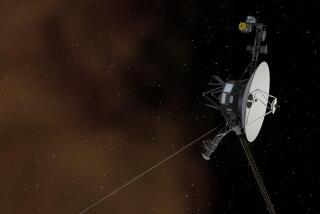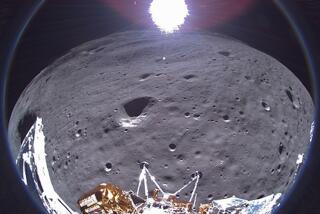NASA ends work to restore planet hunter Kepler to full function
NASA scientists said Thursday that the agency will no longer attempt to restore full function to the exoplanet-hunting Kepler space telescope, which has been hobbled since the spring.
A three-month effort to return the craft to working order, completed just last week, was unsuccessful, said Kepler deputy project manager Charles Sobeck during a phone call with reporters.
Reaction wheels that help the craft focus on far-off stars “are sufficiently damaged that they cannot sustain spacecraft pointing control for any extended period of time,” he said, adding that the space agency will now focus on figuring out how it might still use the telescope with only two fully functioning reaction wheels.
Scientists who are interested in finding Earth-like planets outside of our solar system have regarded the Kepler mission as a big success. By observing slight dips in the light from distant stars — which correspond to planets “transiting” between their host stars and the telescope’s lens — Kepler has discovered 135 confirmed planets and 3,548 planet candidates.
Scientists are still analyzing Kepler data in search of more exoplanets, including Earth-sized planets orbiting sun-like stars in the “habitable zone” — at a distance where liquid water can exist on the planet’s surface.
William Borucki, Kepler’s science principal investigator, said he expected scientists would find signals from such a planet in the data Kepler has already collected.
“The best is yet to come,” said NASA Astrophysics Division director Paul Hertz.
Kepler ran into problems in July 2012 when one of the wheels that help the telescope focus on far-off stars stopped working. When a second wheel failed this May, Kepler could no longer seek out exoplanets, because the telescope needs three working wheels to control its movements in three separate axes. It has four wheels total.
Hertz said that the space agency would now conduct two studies: an engineering study to determine what operations are possible for Kepler with only two working wheels, and a separate study to determine what scientific explorations might be possible under such conditions and whether they would be worth funding.
In August, engineers at Langley Research Center in Hampton, Va., sent out a call for ideas on how they could use the two reaction wheels and Kepler’s thrusters together — rather like using a cane to help the spacecraft as it hobbles around on two wheels — and what resources it would take to get the spacecraft on its feet, however shakily.
“The key to performing science with the Kepler observatory is maintaining the best pointing stability … for the longest time period possible,” according to the request. But the thrusters’ last remaining stores of fuel are a precious resource that will have to be used wisely, said Sobeck, Kepler’s deputy project manager.
“If we use it all up, we don’t have any left,” Sobeck said.
Officials at the Ames Research Center in Mountain View (where the mission’s current operations are headquartered) also sent out a request for ideas on how to make do with the spacecraft’s now-limited abilities. Such plans would use the spacecraft and its single instrument to perform different kinds of experiments that would not require the exquisite pointing precision that three working reaction wheels gave Kepler. Pulling in perspectives from the scientific community would help NASA determine whether the science they could get out of a repurposed mission would be worth the trouble, Hertz said.
“Consideration will also be given to modifications of instrument operation, including possible changes to flight software to take better advantage of hardware capabilities,” according to the Ames request for ideas. “Note that changes to flight software are very time and cost intensive.”








